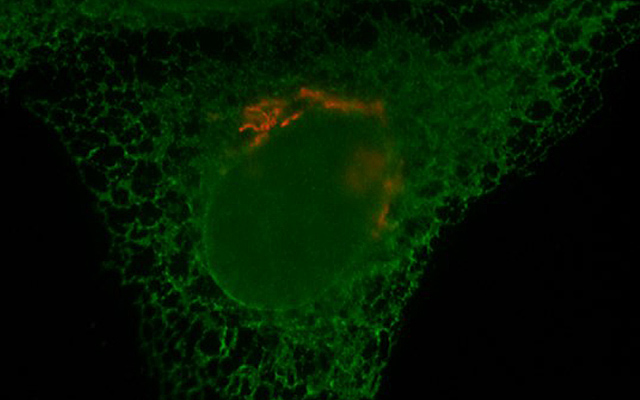Single Enzyme’s Far-Reaching Influence in Human Biology and Disease
Enzyme Fam20C chemically modifies more than 100 different secreted proteins, thus directing numerous cellular processes
Published Date
By:
- Heather Buschman, PhD
Share This:
Article Content

Every cell in the body uses phosphorylation, the process of adding a chemical tag to control a protein’s function and fate, such as when it moves from one part of a cell to another or binds to other proteins.
The process is well understood for most proteins operating inside a cell, but remains a mystery for proteins outside the cell. Yet much of human health and disease relies upon proteins working outside cells, from wound healing to bone formation. Researchers at University of California, San Diego School of Medicine have made the surprisingly simple discovery: The phosphorylation of more than 100 secreted proteins is the work of a single enzyme called Fam20C. The finding is published June 18 by Cell.
“This study opens an entirely new area of discovery for many aspects of cell biology and biomedical research — how cancer cells metastasize, for example – and provides many new therapeutic targets,” said senior author Jack Dixon, PhD, professor in the UC San Diego School of Medicine and associate vice chancellor of Scientific Affairs.
For example, newborns who inherit a mutation in the Fam20C enzyme have a rare disease known as Raine syndrome. The lack of fully functional Fam20C results in bone deformities and the condition is usually fatal at birth. At the opposite end of the spectrum, many types of cancer are known to overproduce Fam20C.
To further probe Fam20C’s role in human health and disease, Dixon’s team used a popular new gene-editing technique known as CRISPR/Cas9 to delete the Fam20C gene from liver, breast and bone cancer cells grown in the lab. Then they collected the fluid that those Fam20C-deficient cancer cells and non-manipulated cancer cells were grown in and analyzed the proteins each sample contained. To their surprise, the researchers discovered that it wasn’t just proteins involved in bone mineralization that Fam20C acts upon. Rather, for each cell type, 90 percent of secreted proteins are phosphorylated by Fam20C — more than 100 different proteins in total.
Dixon’s team also looked at the ability of breast cancer cells to migrate and invade surrounding tissues, with and without Fam20C. In a series of lab tests, they found that cells lacking the enzyme are severely inhibited in their ability to move. That means that, in a real-life case of breast cancer, Fam20C might help tumors metastasize.
“Nearly 60 years of protein phosphorylation research has uncovered many important functions for phosphorylation of proteins inside the cell, so there’s no reason to believe these mechanisms will be any different for phosphorylation of proteins outside the cell,” said Sandra Wiley, PhD, staff research associate in Dixon’s lab and co-first author of the study. “We’re now investigating the biological function and importance of each protein phosphorylated by Fam20C.”
Co-authors of this study include Vincent S. Tagliabracci, Lisa N. Kinch, University of Texas, Southwestern Medical Center; Eric Durrant, Jianzhong Wen, Junyu Xiao, Jixin Cui, Kim B. Nguyen, James L. Engel, UC San Diego; Xiao Guo, Joshua J. Coon, David J. Pagliarini, University of Wisconsin-Madison; Nick Grishin, University of Texas, Southwestern Medical Center and Howard Hughes Medical Institute; and Lorenzo A. Pinna, University of Padova and Venetian Institute of Molecular Medicine.
This research was funded, in part, by the National Institutes of Health (grants DK018849-36, DK018024-37, K99DK099254, R01DK098672, GM094575), Welch Foundation and AIRC.
Share This:
You May Also Like
Stay in the Know
Keep up with all the latest from UC San Diego. Subscribe to the newsletter today.



